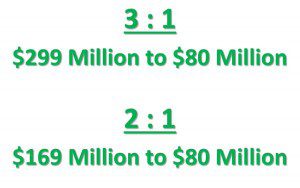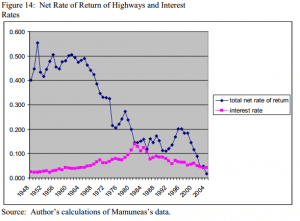The above graphic was used by Governor Walker to sell state investment in an infrastructure project. His presentation was based on assessing how much state tax revenue would be created by investing state dollars in the project.
I’ve got my differences with the Governor on many issues, but the presentation this graphic came from is not one of them. If only every infrastructure project received this kind of analysis that presented a clear case for a net benefit to the state. Of course, the paltry investment of $80 million listed above is far too small to represent the cost of a typical highway expansion project, whose costs just for the expansion of one lane can be $200 million. But that begs the question: If such a complete analysis is warranted for an $80 million investment, why shouldn’t it be applied to a billion dollar project like the zoo interchange?
If turns out I filed an open records request with the Governor’s office back when he introduced his budget, asking for just this kind of information. Here is a list of the documents I received:
- RECORDS PART 1
- RECORDS PART 2
- RECORDS PART 3
- RECORDS PART 4a- p.1-5
- RECORDS PART 4b
- RECORDS PART 5
- RECORDS PART 6
- RECORDS PART 7
- RECORDS PART 8
- RECORDS PART 9
- RECORDS PART 10
- RECORDS PART 11
- RECORDS PART 12
- RECORDS PART 13
- RECORDS PART 14
- RECORDS PART 15
What these documents contain is derived from what WISDOT produces based on an enumeration process that is statutorily mandated in Admin Code Trans 210. A nice visual summary of the scoring process is on page 4:

Do you see the part where the increased tax revenue is calculated for the state? Don’t bother, you won’t find it. If our politicians are wondering why we have a problem balancing revenue with “needs”, look no further! The lack of a mandate to ensure that investments are self-supporting is the answer they seek.
It would be reasonable to wonder if the Governor’s Transportation Projects Commission, in approving the enumeration of projects, would be diligent enough to request this information. The answer is they are not, which can be seen from the minutes of the Nov 2, 2011 TPC meeting included in PART 1 linked above. The major concern expressed was not the return on investment, but that local aids be maintained. So much for diligence.
It would also be reasonable to wonder if the economic benefits of the interstate system were still as potent today as they were back when President Eisenhower pushed for the Interstate System when it took weeks to ship products from one coast to the other. If true, that would absolve WISDOT and the TPC from any responsibility to consider the return on investment. However, a 2009 study clearly shows that the returns of the 60’s no longer exist today, with the latest data point suggesting the costs of financing highways exceeds the net returns:
As a final resort, one might turn to a WISDOT economist and ask if there is any way to quantify the return to the state. In fact, I did this back in 2013. Here is the reply I got:
There is no statewide study of returns on highway investment or the impacts on GRP or consumption in Wisconsin that I’m aware of. The methodological issues are complex, and the necessary data for such a study just isn’t available.
– Robert Russell, DOT (Economic Development)
Which brings me back to my point: If we can quantify the returns to the state for an $80 million investment in a sports arena, why isn’t it possible, with “big data” technology, to insist on obtaining a similar metric before approving $1.3 billion of highway bonding in the Governor’s proposed budget? That might just be more productive than trimming out, root and branch, bicycle and pedestrian project mandates from across the budget.







Excellent points. They need wider distribution. This is not just a Wisconsin problem.
Great article!